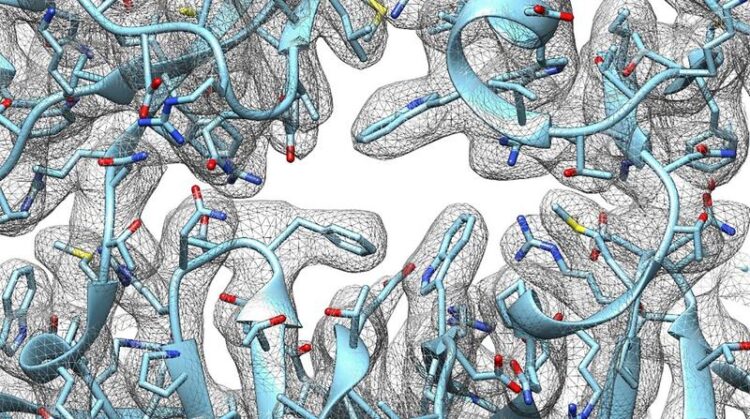Bacteria under stress

The figure shows a section of the structure of the bacterial mechanosensitive channel YnaI. The picture shows a portal that salt ions have to pass.
AG Boettcher, RVZ
In stress situations, bacteria use special ion channels for defense. Understanding how they function provides the basis for combating harmful bacteria. A Würzburg research group in cooperation with ETH Zurich and the University of Oxford has now been able to decipher how two of these channels are structured and how they open up. The results were published in the renowned journal PNAS.
If it starts to rain, this can be a dangerous situation for bacteria. Due to the decreasing salt concentrations in the environment, water flows into the cell with the higher ion concentration for compensation and causes the cell to burst. As a defense mechanism, the bacterium Escherichia coli has seven different types of channels in the cell membrane. These channels function like doors and can channel ions into the cell or out of the cell.
The research group of Prof. Bettina Böttcher from the Rudolf Virchow Center for Integrative and Translational Bioimaging at the University of Würzburg has now succeeded in deciphering the exact molecular structure of two more of these channels using electron cryomicroscopy. The study is an international collaborative work with the groups of Prof. Rainer Hedrich from the University of Würzburg, Prof. Mark Sansom from the University of Oxford and Prof. Renato Zenobi from the ETH Zurich.
By knowing the high-resolution structures, the scientists can on the one hand distinguish the different channels and on the other hand better understand how exactly the opening mechanism, i.e. the “door handle”, works. “Only if we understand bacterial defense mechanisms in detail can we successfully combat pathogenic bacteria,” emphasizes Böttcher. “Mechanosensitive channels are also involved in other important biological functions, such as blood pressure regulation and hearing. However, their basic mechanisms have not yet been sufficiently researched. This is why basic research is so important here,” adds Dr. Tim Rasmussen, who is a post-doctoral researcher in the Böttcher group.
Persons
Prof. Bettina Böttcher is Professor of Biochemistry and since 2016 head of a research group at the Chair of Biochemistry and at the Rudolf Virchow Center for Integrative and Translational Bioimaging at the University of Würzburg.
Dr. Tim Rasmussen works as a postdoc in the research group of Prof. Bettina Böttcher at the Rudolf Virchow Center for Integrative and Translational Bioimaging at the University of Würzburg.
Wissenschaftliche Ansprechpartner:
Prof. Dr. Bettina Böttcher (Rudolf-Virchow-Zentrum, Universität Würzburg)
Tel.: +49 (0)931 31 84193, bettina.boettcher@uni-wuerzburg.de
Dr. Tim Rasmussen (AG Böttcher, Rudolf-Virchow-Zentrum)
Tel.: +49 (0)931 31 89659, tim.rasmussen@uni-wuerzburg.de
Originalpublikation:
Vanessa Judith Flegler, Akiko Rasmussen, Shanlin Rao, Na Wu, Renato Zenobi, Mark S.P. Sansom, Rainer Hedrich, Tim Rasmussen and Bettina Böttcher; The mechanosensitive MscS-like channel Ynal has a gating mechanism based on flexible pore helices. PNAS (November 2020) https://doi.org/10.1073/pnas.2005641117
Weitere Informationen:
https://www.uni-wuerzburg.de/en/rvz/rvz-news/single/news/bacteria-under-stress/
Media Contact
All latest news from the category: Life Sciences and Chemistry
Articles and reports from the Life Sciences and chemistry area deal with applied and basic research into modern biology, chemistry and human medicine.
Valuable information can be found on a range of life sciences fields including bacteriology, biochemistry, bionics, bioinformatics, biophysics, biotechnology, genetics, geobotany, human biology, marine biology, microbiology, molecular biology, cellular biology, zoology, bioinorganic chemistry, microchemistry and environmental chemistry.
Newest articles

Innovative 3D printed scaffolds offer new hope for bone healing
Researchers at the Institute for Bioengineering of Catalonia have developed novel 3D printed PLA-CaP scaffolds that promote blood vessel formation, ensuring better healing and regeneration of bone tissue. Bone is…

The surprising role of gut infection in Alzheimer’s disease
ASU- and Banner Alzheimer’s Institute-led study implicates link between a common virus and the disease, which travels from the gut to the brain and may be a target for antiviral…

Molecular gardening: New enzymes discovered for protein modification pruning
How deubiquitinases USP53 and USP54 cleave long polyubiquitin chains and how the former is linked to liver disease in children. Deubiquitinases (DUBs) are enzymes used by cells to trim protein…



